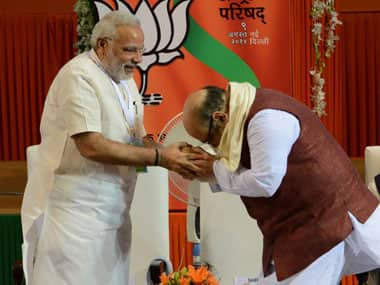The Congress could be voted out in the elections being held in Maharastra and Haryana today, but for the challenger, BJP, the stakes are much higher than the party that currently is in power in the two states. Today’s polls, the first state elections since Narendra Modi decisively swept the parliamentary polls in May, has many other firsts to its credit and will have implications on national politics, beyond just the simple detail about who would come to power in the two states It will test whether the broad national trend where voters have expressed clear preferences about who should lead the government and decisively voted for him or her, whether for Parliamentary or state assembly elections. Will the voters would go by that same national trend or give a fractured mandate like they did in Delhi last year? In the states going to the polls, it has broadly been a two-way race and the parties, other than those attached to the two principal sides, only ended up in also ran category. For decades the electorate had simple choices but in these elections, it has suddenly became complicated and they didn’t have much time to weigh their options. Now what was once bi-polar electoral battle turned into a multi-cornered contest. [caption id=“attachment_1757375” align=“alignleft” width=“380”]  Can the Modi, Shah combination take the BJP to victory? AFP image[/caption] The BJP’s belief in Modi’s charisma, making voters ignore the party’s structural weaknesses on the ground, will be tested. Will voters go with the party’s catch phrase, ‘Chalo Chale Modi ke saath’, or will they look for some thing more local? The Congress has been thoroughly vanquished, not even getting the status of the main opposition party in the Lok Sabha, that a potential loss in Maharastra and Haryana, where the party has been in power for 15 and 10 years respectively, will make a huge difference to the prospects of the decaying Grand Old Party. Getting thrown out of power in the two states would effectively mean that the Congress is nowhere close to recovering from the Lok Sabha elections. It will be important to see what numbers Congress eventually gets. In the event of a loss, party loyalists will proclaim that the results were no reflection on the leadership of Sonia Gandhi and Rahul Gandhi. The Congress has been readying its defence by not getting them to intensively campaign in both states. As elections loom, alliances are formed or existing allies find realpolitk calculations and compulsions to hang on to each other with greater vitality, but just the opposite has happened in Maharastra. Not only did challengers BJP and Shiv Sena split up, the ruling coalition of Congress-NCP also went their separate ways. In Haryana, the BJP parted ways with its three-year-old ally HJC. The results would perhaps been a forgone conclusion if the BJP preserved its alliances with Shiv Sena in Maharastra and HJC in Haryana. Going by the popular mood during the campaign period it looked as though the BJP is better placed in Maharastra than in Haryana. Modi and Amit Shah have played a bold gambit. Modi would further be strengthened, both as Prime Minister and the supreme leader of the BJP if the party does well in two states. He would have effectively proved that he, after Indira Gandhi, is the most powerful leader of independent India. Never before a Prime Minister campaigned so intensively, making rivals of most unlikely combinations – Sharad Pawar, Prithviraj Chavan, Uddhav Thackeray, Raj Thackeray, Bhupinder Singh Hooda, Om Prakash Chautala and his clan. Modi as usual drew huge crowds and wild cheers. But in the absence of any effective state leadership will his persona be powerful enough to take the BJP to power in Maharastra, where it had been a junior partner, and in Haryana it was just a fringe player limited to some urban pockets? A positive showing on 19 October would also be a reaffirmation of Amit Shah as a master strategist. But if things go wrong, even in one state, questions would be raised on Shah’s leadership. There may not be any open dissent but murmurings would be loud enough to go beyond close party circles. Either way expect the fireworks to begin well before Diwali.
The BJP’s belief in Modi’s charisma, making voters ignore the party’s structural weaknesses on the ground, will be tested.
Advertisement
End of Article


)
)
)
)
)
)
)
)
)



